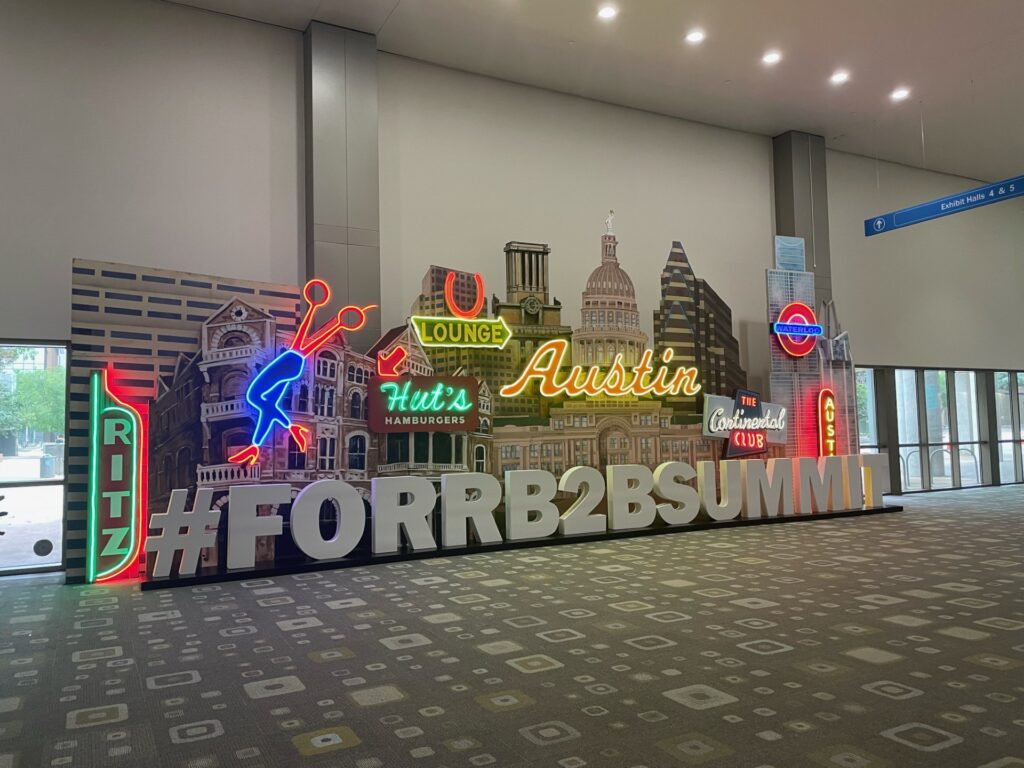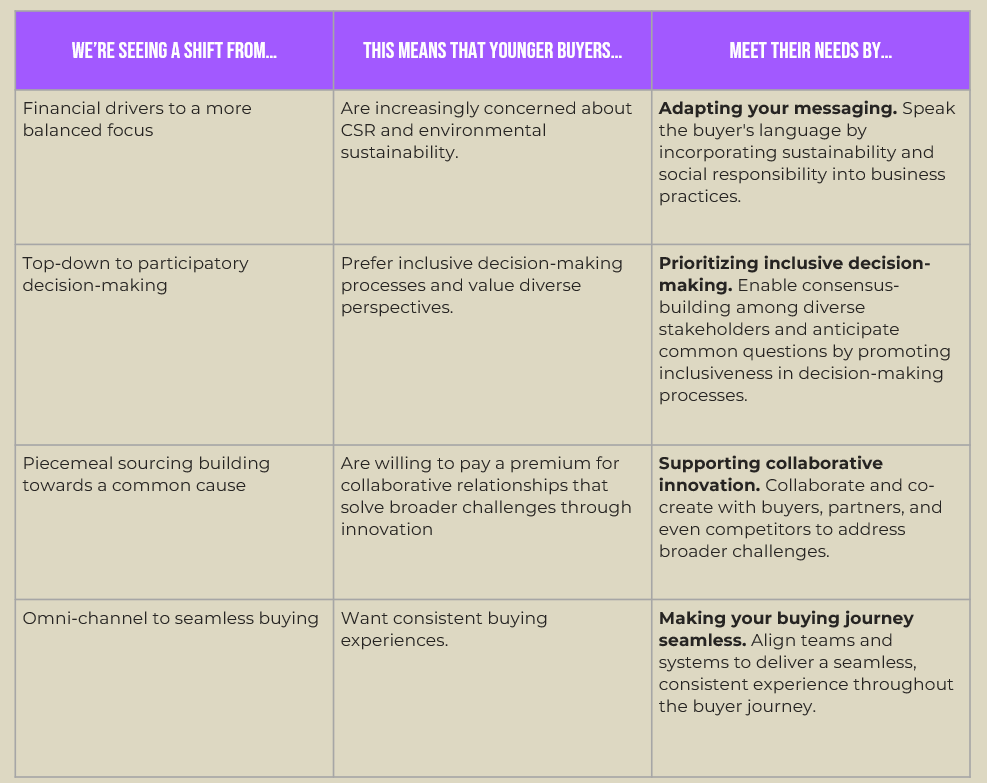We’re only two days into Forrester’s B2B Summit 2024, and our team is already bursting with insights — and hungry for more. With two further days of keynote sessions, workshops, and networking events ahead of us, we’re breaking down what we’ve learned during the past 48 hours in Austin, Texas.
Between catching up with clients and colleagues from across the country and enjoying local Austin delicacies, our team was able to visit three incredible events where they heard directly from Forrester’s top analysts and VPs.
So, what can our crew of savvy B2B marketing experts learn from Forrester? Well, a lot, it turns out!
Read on for our key takeaways from each of the sessions:

Sunday, May 5, 2024 | Forrester Certification Workshop: Optimize The Revenue Process For Growth
Speakers: Terry Flaherty, VP, Principal Analyst, Forrester & Jenna Wohead, Director, Product Management, Forrester
We started the week (or ended it, depending on how you look at things) with an interactive workshop led by Terry Flaherty, Forrester’s Vice President and Principal Analyst. This session was a great way to kick off the summit and got us thinking about how we, as B2B marketers, can make the most of revenue-boosting opportunities by leaving lead-centric marketing in the rearview.
So, how does Flaherty suggest B2B marketers optimize revenue processes for growth? By adopting an opportunity-centric revenue model, such as Forrester’s B2B Revenue Waterfall framework. Let’s break it down.
What is Forrester’s B2B Revenue Waterfall framework?
The B2B Revenue Waterfall framework is a golden ticket for modern B2B organizations aiming to optimize their revenue processes. Why? Because it prioritizes opportunities over leads, focusing on understanding and engaging buying groups early in the process.
And it works. Forrester clients that have successfully implemented the Waterfall have seen huge improvements in conversion rates and revenue growth, ranging from 40% to 400%.
Why an opportunity-centric approach works
Forrester recommends adopting an opportunity-centric approach to optimize revenue growth. Let’s examine why this approach works and Flaherty’s advice for implementing it correctly.
1. Opportunity-centric thinking is powerful. While traditional B2B marketing methods focus on individual needs, the reality is that multiple people tend to be involved in B2B purchasing decisions. So, growth-minded marketers should focus on identifying multiple opportunities within buying groups, looking for those that are aligned with your product offering, and maximizing the revenue potential of the opportunity.
2. Challenging your culture is non-negotiable. Culture is the top reason companies give for why they’ve not yet implemented an opportunity-centric approach. Making this shift can be challenging due to ingrained corporate cultures where executives are accustomed to measuring marketing success through traditional MQL metrics, but if you want to grow, you need to forget what you’re used to.
3. Watch for signals and tune out the noise. Intent signals are your best friends; learn to read them right, and you can catch potential opportunities before your competition has even blinked. This is because they help you move from reactive to proactive sales while prioritizing high-propensity opportunities.
First-party and third-party signals are critical for identifying buying groups and their stages in the buyer journey. Compared to getting an MQL, identifying anonymous visitor traffic to your site can help uncover opportunities much earlier in the process. Signals include direct interest, content consumption patterns, and third-party intent data from platforms like Bombora.
4. Craft an approach that fits your organization. There’s no one-size-fits-all approach here, folks. There are multiple ways you can approach operationalizing the Waterfall, ranging from leveraging Business Development Representatives (BDRs) to creating opportunities upfront based on intent signals — the right fit for you depends on your organizational maturity, tech stack, and alignment between marketing and sales.
Our big takeaway: stop chasing leads
5-10% of companies have started to adopt an opportunity-centric approach, and around 50% of companies have made the transition a top priority in 2024.
If you want to see improved revenue growth, say goodbye to lead-based approaches. Shifting to an opportunity-based approach, such as Forrester’s B2B Revenue Waterfall, can help identify and engage buying groups more effectively. This approach offers a host of benefits, including improved conversion rates, stronger alignment between marketing and sales, and optimized revenue growth.
Monday, May 6, 2024 | Keynote: A New Generation Of Buyers Will Force B2B Reinvention
Speaker: Amy Hayes, VP, Research Director, Forrester
Once Monday rolled around, our team was all fired up and excited to join the day’s keynote session with Amy Hayes, Forrester’s VP Research Director. This incredible session zeroed in on the changing preferences and behaviors of a new breed of B2B buyers — young people under the age of 45. Plus, Hayes laid out exactly how marketers need to shift their strategies to cater to this younger audience.
And, yes, 45 is young!
“These younger buyers have never heard the sound of a fax machine screeching in the background. They don’t even like email. That’s old school; they prefer to be reached on their phones in Teams or Slack.”
If you want to navigate this wave of transformation, you need to understand the new generation’s priorities, which include social responsibility, environmental sustainability, and a more participatory decision-making process.
Four behavioral shifts defining the new BAU — and the implications for marketing and sales
Younger buyers are changing the game… and marketers need to react accordingly if they want to win. Here’s how we recommend reacting to the four key behavioral shifts Forrester’s analysts have identified that are affecting how younger buyers interact with B2B organizations.
“It’s time for a reinvention; whatever’s here today is not going to bring us success for tomorrow.”

Our big takeaway: Hello, corporate social responsibility!
If you want to target the under-45 demographic, you can supercharge your engagement by speaking their language. This means aligning your key messaging with corporate social responsibility (CSR) and sustainability in addition to environmental profitability.
This will go a long way toward supporting inclusive decision-making, promoting collaborative innovation, and ensuring a seamless buying journey for customers — all things this young and socially conscious demographic cares about.
Monday, May 6, 2024 | Segment Your Market By Buyer Needs To Find Your Ideal Customer
Speaker: Beth Caplow, VP, Principal Analyst, Forrester
This session on needs-based customer segmentation with Beth Caplow provided our team with loads of great insights and we’re excited to share the goods with you.
So, what’s the skinny? According to Caplow, the secret to providing unparalleled value to customers is to segment your market by grouping customers based on their specific needs — and then aligning your offerings perfectly with these needs.
Here’s how to do just that in seven steps:
1. Identify your customers’ needs. Using internal insights (think, win-loss analysis, financial data, industry reports, conversational intelligence, and discussions with sales teams) and external market research, you can get a clear picture of your customers’ desires. Make a note of those that offer potential business value.
“There’s so much information that you can gather inside of your own company… win-loss analysis, financials, industry reports, conversational intelligence – all are valuable.”
2. Create customer clusters. Using the information you’ve collected, create clusters of customers based on common needs. This will help you identify attributes that indicate a higher propensity to purchase.
3. Build a segmentation model. Plot your identified customer attributes on spectrums, such as traffic volume and product value, to create a segmentation model.
4. Develop your ideal customer profile (ICP) Using Forrester’s Relative Targeting Framework. Create your ICP by evaluating market attractiveness, strategic fit, and ability to win.
5. Select the best-fit segments. Plot your customer segments on a 2×2 matrix based on market attractiveness and strategic alignment, which will help you identify the most valuable opportunities.
6. Get ready for targeting. Convert the most valuable attributes into qualitative data, making for easier targeting.
7. Activate your plan! Finally, you’re ready to activate your model and start winning big!
It seems so simple when you see it broken down like that, right?
Our big takeaway: Needs-based segmentation always triumphs
Needs-based segmentation provides a structured approach to understanding customer requirements, allowing businesses to identify, prioritize, and target customer groups with the highest propensity to buy.
By converting qualitative needs into quantitative data, businesses can more easily align their strategies and offerings with customer needs, paving the way to improved market penetration.
What’s next?
Stay tuned and follow B2B IQ for more insights from this week’s summit!


